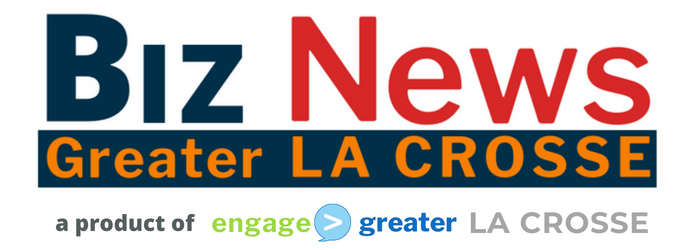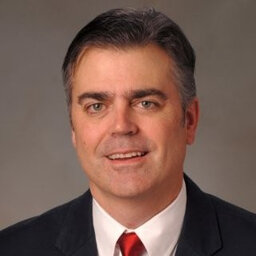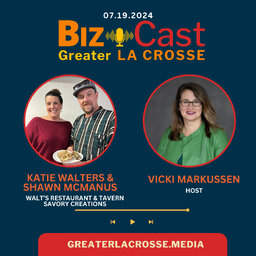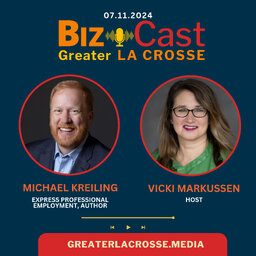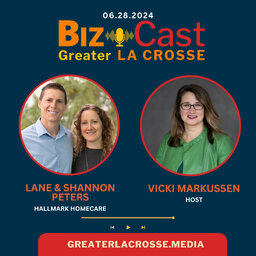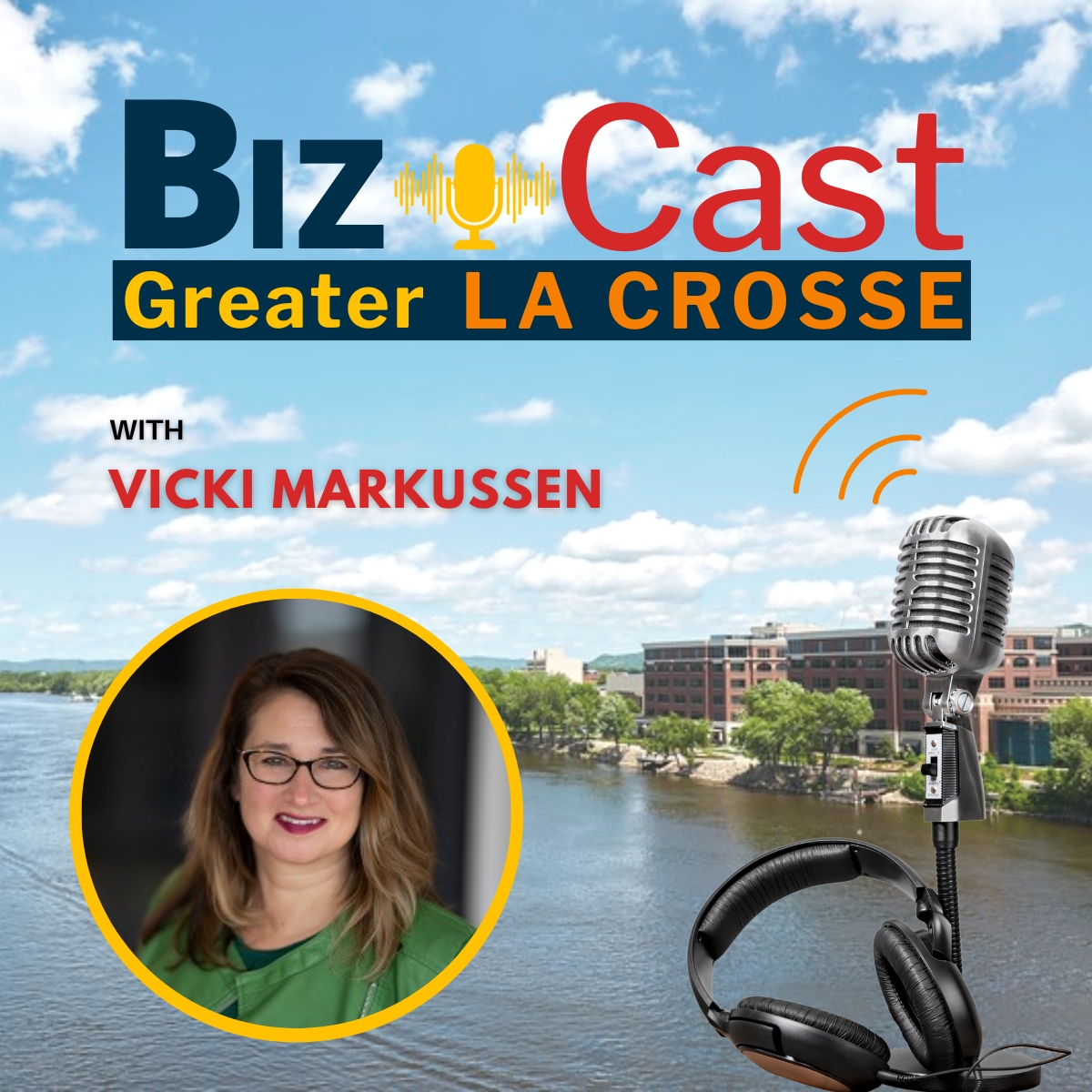
Episode 17
Award-Winning Inland Packaging: Growth from Business Cards to Food Packaging
About BizCast Greater La Crosse
We bring you news from the business community. From startups to experienced problem solvers, you’ll get in-depth insight on the challenges and opportunities of doing business in Greater La Crosse. Our show is a collaboration between WIZMNews.com and BizNews Greater La Crosse ( GreaterLaCrosse.media ).
Full Transcript [ generated by AI]
2023-04-28 Mark G
[00:00:00] Mark Glendenning: so one day, 1944, he’s in lacrosse. Says, boy, I’d love to move my family here. Owner of his supplier says, well, John, you’re in luck.
[00:00:07] Mark Glendenning: Inland printing down the street is for sale.
[00:00:10] Vicki Markussen (2): Welcome to Biz Cast Greater Lacrosse, a weekly podcast from Biz News. We bring you news out of the business community. I am your host, Vicki Markson. In joining me today is Mark Glenn Denning. You are the. Third generation owner of inland. Describe what inland does now, and then give some of the history.
[00:00:30] Mark Glendenning: So today what people around town would know is inland printing is actually inland packaging. A hundred percent of what we do is labels and or packaging. So flexible packaging and or primary labels. Today we’ve got three factories in lacrosse plus a warehouse, and then we’ve got three additional factories outside of lacrosse.
[00:00:49] Mark Glendenning: One in Nina, Wisconsin, one in just outside of Milwaukee, and then one just outside of Philadelphia, Pennsylvania. I’m gonna
[00:00:57] Vicki Markussen: pause you right there. Why are the three locations
[00:01:00] Mark Glendenning: three in LA Cross?
[00:01:01] Vicki Markussen: Three well, commun, uh, three communities.
[00:01:03] Mark Glendenning: The reason that we, those were all acquired. So the ones outside of lacrosse were all m and a and we acquired those businesses primarily to get different products, really to extend out our product reach and technology.
[00:01:16] Mark Glendenning: And obviously people. So that was really the reason for doing it. And what we do in lacrosse. We’ve done a long time easy to support or relatively easy to support in lacrosse with people. The things that we had to get into, not so much. So obviously in lacrosse, Wisconsin, if you wanna do screen printing, you got you, you have a lot of people to rely on if you want to do a lot of the things that.
[00:01:36] Mark Glendenning: We needed to do, not so much. So that’s why we looked at other areas and east side of the state is huge into labels and flexible packaging. And actually Pennsylvania, New Jersey area is also really, really big in it. So that those were pretty natural areas to look at for acquisition.
[00:01:52] Vicki Markussen: Yeah. So as you’re looking to diversify, if you will, your offerings.
[00:01:56] Vicki Markussen: Absolutely. You buy out those companies, you gain their technology, you gain those. That customer base, and then it’s up to you to go, how do we grow it? Grow it, right? Yeah. I still wanna get into the history, explain why three locations in lacrosse.
[00:02:11] Mark Glendenning: We have three locations in lacrosse. Primarily because the technologies are so different.
[00:02:16] Mark Glendenning: We had a second location up at the airport industrial park, as we moved into really new technology that would not have fit. Into our West Avenue building. Mm-hmm. And really split apart a couple of processes that really should have never been put together.
[00:02:29] Mark Glendenning: So we got some benefit out of it, new technology cleaner facility for gravure, a speci specific environment for offset that you really need. And so that’s why we had those two, and then the third factory that we opened in 21. Mm-hmm. Great timing. Right after. Mm-hmm. Covid.
[00:02:44] Mark Glendenning: That’s right. Yeah. Been supply chain disasters. Mm-hmm. We opened that factory because it’s really focused on our injection in mold. So think like the Philadelphia cream cheese tubs. Yeah. And that’s just such different technology.
[00:02:57] Vicki Markussen: Interesting.
[00:02:57] Mark Glendenning: And I would
[00:02:58] Vicki Markussen: Imagine that location too just has easy access. It does. In
[00:03:02] Mark Glendenning: and out. Yeah, you do. You’ve got great service from ups. FedEx is right there. The airport’s right there.
[00:03:08] Mark Glendenning: Interstate is right there. So yeah, that’s been a very good industrial park for us.
[00:03:13] Vicki Markussen: But your admin offices
[00:03:15] Mark Glendenning: , most of them are in West Avenue. Support, sales, all that type of stuff. And then if it supports the direct factory mm-hmm. Then most of those folks are solid airport road.
[00:03:25] Mark Glendenning: Yeah.
[00:03:25] Vicki Markussen: Yeah. Okay, that’s a good segue to history.
[00:03:29] Mark Glendenning: History. So it all began with my grandfather, John Glendenning, and he and his family lived in Detroit, Michigan. He was a print salesperson. He had a supplier in La Crosse, Wisconsin. Hmm. It was not inland printing. And he would come here by train, once or twice a year.
[00:03:46] Mark Glendenning: Think 1940s, Detroit going the wrong direction. Mm-hmm. Busy, but going the wrong direction. Lacrosse as beautiful as ever. And every time he’d come here, he’d remark how much he loved the area. Hmm. And so one day, 1944, he’s in lacrosse. Says, boy, I’d love to move my family here. Owner of his supplier says, well, John, you’re in luck.
[00:04:04] Mark Glendenning: Inland printing down the street is for sale. Grandpa walked down the street, met the business owner, negotiated, bought the business, moved his family in 1944 to lacrosse, Wisconsin. Wow. And that family included my six year old father check. And what type
[00:04:19] Vicki Markussen: of printing were they doing?
[00:04:20] Mark Glendenning: They were doing letter press printing and it was priceless business cards, stationary.
[00:04:27] Mark Glendenning: Just really mundane, kind of one, maybe two color if it was really, really exciting work. So it was that was the work he did. And funny enough, the actual, the facility was at second in Maine and it was a old bank building that had been built in the 1870s. Today’s the parking lot of the Rasson Hotel,
[00:04:44] Vicki Markussen: just kitty corner dress right at this moment.
[00:04:46] Vicki Markussen: That’s exactly
[00:04:47] Mark Glendenning: it. Look, I can stand up and look mm-hmm. And see it. I remembered as a kid, it was a cool old building with stairways that went nowhere and a big bank vault in the basement. And so for a little kid running around a factory, it was pretty cool. Mm-hmm. It was it was also a horrible place to try to do anything efficiently.
[00:05:02] Mark Glendenning: Mm-hmm. We were urban renewed out of it. Mm-hmm. As I said, as they were gonna do the lacrosse center and the radison and all those things, and, We moved into our West Avenue location, which had been the original machine products factory. And so that to us was, one floor much bigger, much better.
[00:05:20] Mark Glendenning: And we grew there for a lot of years. And my dad was the first, actually, so that was this early seventies. My dad was the first glendenning to go away to college. So he, and everybody, like any small family business or small family farm, everybody works. Mm-hmm. So everybody worked at the business.
[00:05:38] Mark Glendenning: My dad, again, was the first one to go away to school. Went to Madison was about to graduate, and my grandfather asked him to come back into the business and finally enticed him with ownership and before graduation. Before graduation. Okay. Wanted him to come back in a leadership role and even offered him a part of the business.
[00:05:55] Mark Glendenning: And my dad always laughed because he said, here I am, I go get a college degree and it takes my father to teach me that negative equity really isn’t worth anything. Mm-hmm. It but my dad came in to the business, did a great job. So he took us, the business that grandpa bought in 1944 was exactly the same business in 1960.
[00:06:11] Mark Glendenning: Same technology same, process, same customers. And my dad, Wanted none of that. So although my grandfather Al, I always like to give my grandfather credit for our mission, which is customer satisfaction, customer delight. And grandpa, again, being a print salesperson, that was hugely important.
[00:06:28] Mark Glendenning: My dad is really the one who built our vision, which is growth for customers, growth for our team members and growth for our communities. And that was 100% of my dad. And so he took us into new technology like Offset in the sixties, gravure in the eighties. He’s also the one that made the best decision, which was.
[00:06:43] Mark Glendenning: Taking us into labels in the seventies.
[00:06:46] Vicki Markussen: How did that transition, to the new product, to the labeling? How did that go?
[00:06:51] Mark Glendenning: Labeling was actually, we had gi and brewing back then was a customer.
[00:06:55] Mark Glendenning: Mm-hmm. And we, at that point, so seventies, we had offset technology.
[00:07:00] Mark Glendenning: They were a customer on the commercial side. We did a lot of their point of sale. And because we had the offset technology, we were able to make quick labels for them for some of the mandatory information that the government was now requiring.
[00:07:14] Mark Glendenning: And because that worked, we just did more and more and more of those types of labels and then, expanded out that, that label offering and and that’s how we grew for the seventies, eighties, and really into the nineties. Was that
[00:07:26] Vicki Markussen: predominantly
[00:07:27] Mark Glendenning: G Heilman? No Heman was a good customer for a lot of those years, but we started to do more and more beer customers and a really more and more beverage customers.
[00:07:36] Mark Glendenning: And that’s really where we grew. And then I’d say in the nineties we started to pick up some food customers. And that really grew because as we really as the ocean that used to be, beer became more of a pond. We had to find a new ocean and that was food. And so then we went into food.
[00:07:51] Mark Glendenning: And then as we got into, more markets more of the markets required different technologies. Mm-hmm. And so needing different technologies, some expanding our lines. So if it fit in what we did well here in lacrosse, we were able to bring that technology into lacrosse. But the other thing that we, is, we got new customers.
[00:08:11] Mark Glendenning: They also didn’t just need this, the types of labels that we could produce today in lacrosse. They also needed other technologies. And so that really led to our m and a strategy. Mm-hmm. And so we bought our first company in 2015. And then another one in 16 and another one in 2020. So we’ve done three acquisitions to really expand our product, offering, our technology, our process, and get really good people in areas that obviously are.
[00:08:38] Mark Glendenning: Also favorable for workforce development.
[00:08:41] Vicki Markussen: So your dad got the company into labels?
[00:08:45] Vicki Markussen: Yep. Where were you in this?
[00:08:47] Mark Glendenning: So I’ve got an older sister, younger brother. We both, all of us worked in the business because even though dad was growing the business, it was still relatively small. And so we all worked in the business. My dad always felt like he would’ve been better served if he would’ve gone and worked for somebody else before coming in, even though he did a great job.
[00:09:03] Mark Glendenning: I mean, did a fantastic job. And so we, although he was happy to have us work, We never talked about coming back into the business. And so he, he wanted us to go find where our passion lied. And he felt that if for whatever reason, our paths crossed we’d deal with it then.
[00:09:21] Mark Glendenning: And so I was I was working for Eden Corporation Color Hammer and Matic products in Chicago as a sales engineer for them after college went to Madison. And our largest customer, again, was Jaman Brewing. They were bought some people remember they were bought by an Australian brewer mm-hmm.
[00:09:37] Mark Glendenning: Bond. Mm-hmm. Yeah. And he came into lacrosse and promptly moved headquarters to Chicago, Illinois. So at that time they were well over 50% of our sales. Dad really felt like he needed representation. I was already looking because the one thing that, I really enjoyed the front end of working for a very large corporation, but as I started getting into my career, that whole big corporate thing was really foreign to me, and I didn’t.
[00:09:58] Mark Glendenning: I knew I, I was not going to do well in a large corporation. So I was already looking and, dad felt like, Hey, we need a representation in Chicago. So we talked in 1988, I came on board as the Chicago sales rep in in Chicago, Illinois, with primary responsibility for Jaman Brewing. And then I was able to move back to lacrosse.
[00:10:17] Mark Glendenning: We kept growing. I saw opportunities for, some of the stuff that I had, studied in school and done on the first part of my career at Eaton. And. Came back to lacrosse and became president in 99 and c e o in 2001. And
[00:10:30] Vicki Markussen: how many employees were there when you
[00:10:32] Mark Glendenning: started? Oh boy. When I started 70, 80 ish.
[00:10:37] Mark Glendenning: How many do you have now? 420.
[00:10:39] Vicki Markussen: Wow. So these 70, 80, how old were you at the time? When I.
[00:10:44] Mark Glendenning: Came back. Yeah, I was 27.
[00:10:47] Vicki Markussen: So how do you think the employees looked at this and said, uh,
[00:10:51] Mark Glendenning: some said, some said, well, great, and some said, oh I knew everybody. It was, it’s really hard to, when you’re a family business, you don’t separate.
[00:11:00] Mark Glendenning: No, you really don’t. Family doesn’t end right. Mm-hmm. In your house, . So I knew a lot of people. I’d worked with a lot of people. I think they were good. I think most, I think in most family companies, I if they show some competence and that’s still a question mark on me, but I think if, kids have, show some competence and desire and work hard I think it’s, I think people like to see that next generation come in because That means there’s a great chance for it to continue on as it was with that culture.
[00:11:28] Mark Glendenning: And that’s something that I think every family business works really hard on. Culture’s a big
[00:11:32] Vicki Markussen: deal. Absolutely. And I think I’ve seen it happen many times where that next generation comes in. It’s almost expected when you work for family owned business and you see that there are other kids that are coming up, you’ve.
[00:11:45] Vicki Markussen: They had to have known that was a possibility. They
[00:11:47] Mark Glendenning: do, and, and you’ve seen the stats, right? So from first generation to second and there’s a big, pretty big drop off but second to third it’s a crater. Mm-hmm. And I, for the first few years I’d like to say that, well, because we’re now a label company, I’m really Gen two Unlabel.
[00:12:03] Mark Glendenning: Okay. Okay. Cause I didn’t want to be that. Third generation, just in case there was luck, bad luck attached to it. But, and today Margie, my wife and I, we have two sons, Trent and Brad, and they’re both now in the business. So we’ve got our fourth generation now working in, in London.
[00:12:18] Mark Glendenning: I will tell you the rule was different. My dad had wanted no expectation of us coming back in the business, which I think is very healthy. Both my boys worked in the business in high school as much as they could because unfortunately, labor rules had I shouldn’t say unfortunately, but labor rules had changed a bit.
[00:12:33] Mark Glendenning: But as an example, Trent started working in our lab at age 13. He was very good in science. Wow. And yeah, he started working in our quality lab at 13. So both of them worked in the, in, in either the lab or factory. And the rule for us was, okay, there may be a position for you but you are gonna first have to go off and you’re gonna have to work for other people.
[00:12:55] Mark Glendenning: And if there’s an opening that fits, where you want to be. And that hiring manager wants to hire you, you, they think you’re the best candidate, then you’ll get hired. But, I am not a rec, I am not your recommendation and I’ll have zero input on that decision, and I’ll hold the manager accountable.
[00:13:12] Mark Glendenning: And you, I just think that’s the way you have to do it because allowing family members come into a business Where it’s a right, it’s just wrong. There’s just no other way to say it. Right? Yeah. It, so they’ve gotta, you gotta work hard and people look at you, if your last name is the owner’s name, you get looked at a bit differently.
[00:13:30] Mark Glendenning: So absolutely. You have to be thoughtful about that.
[00:13:33] Vicki Markussen: Those poor managers going, how am I gonna explain not hiring the owner’s son?
[00:13:38] Mark Glendenning: No pressure. Probably the harder one would be firing the owner son. But yes, we’ve had history of that too, so, oh, well
[00:13:45] Vicki Markussen: we won’t go into that story. Yes, yes. The dark side of the Glen Dennings, so, yeah.
[00:13:49] Vicki Markussen: Yeah. Okay. So let me take us back on the history path. So what I always find interesting is when those key decisions are made, so you’re making labels. Mm-hmm. You see the. . The ocean. The ocean. Ocean. The ocean, yes. So it becomes a lake and then it becomes a pond. Yeah. Yeah. So you see that shrinking.
[00:14:08] Vicki Markussen: At what point did you realize you needed to diversify your customer base?
[00:14:13] Mark Glendenning: It was really a twofold, so it was both the fact that We were, we were penetrating our initial, our key markets heavily. So we were, getting head market saturation. Yep. A large position.
[00:14:25] Mark Glendenning: Also though the very things that I sold in Chicago, that actually the products that I first sold for Eden Corporation, Which at the time were very new and not very reliable, had become extremely reliable and changed really how almost every machine works, including our equipment today. Mm-hmm. So that allowed our customers to become much more.
[00:14:46] Mark Glendenning: Nimble in what they could use for labeling and packaging. The old, I’ll call it the old days, so pre 2005, our customers, once they decided on this is how we’re going to label our product, that’s what they stuck with. And then as the machines got more and more capable of doing multiple different process, same line we had to we had to follow suit and that really started us looking at new markets and also potentially new product, and I will tell you, typically we would look at new product and find a partner that we could use that would, we could outsource production to.
[00:15:21] Mark Glendenning: Mm-hmm. And in fact, one of those, one of those partners was one of our m and a part a target. Yeah, that, that’s how we did it, that’s why we did it. So
[00:15:28] Vicki Markussen: you, I’m guessing there was a conversation saying, if we’re gonna invest in this technology, how do we maximize that investment? And that gave you the opportunity, if you will, to enter those new markets.
[00:15:39] Vicki Markussen: Absolutely. So what did that product look like? Like it was it still labels? And then how did you get into packaging? What’s that look like?
[00:15:48] Mark Glendenning: So a lot of it was labels and, you the, we were historically a cut and stack producer. That’s what a lot of the beer labels still are today.
[00:15:56] Mark Glendenning: And there’s a lot of food labels that are cut and stacked. You don’t think canned food and you think Clorox wipes and things like that. Mm-hmm. And we still do a tremendous amount of those. But pressure sensitive, so there’s just a different types, pressure sensitive mm-hmm.
[00:16:09] Mark Glendenning: And shrink sleeves and we wanted to get into those markets because we had customers one product line would be on pressure sensitive or shrink. Another line would be on cut and stack. And then this, your comment on flexible packaging. I always like to tell the story of if I go to the store for peanuts, I’m coming home with a jar of peanuts and if my kids go to the store for peanuts, they’re coming home with a flexible package Yes.
[00:16:32] Mark Glendenning: Resealable of peanuts. Yes. And so that, it’s a big and growing market and it was just an area that we, customers were interested in and we felt like we needed to get in as well.
[00:16:41] Vicki Markussen: Yes, dumbing it down. It’s like, do you still buy mayonnaise in the jar or the course Squeezable mayonnaise.
[00:16:46] Vicki Markussen: Yeah. We have that debate in our household too. I’m a JAR guy. Yeah so anyways, that type of thought process of how else can you package the exact same product and then because you’re a service provider to that manufacturer, how do you make sure you have what they need so you can keep them as a customer?
[00:17:02] Vicki Markussen: That that’s exactly it. And so you kind of have to know where they’re going to know when to invest in equipment. You
[00:17:08] Mark Glendenning: do. You do. And it’s like I gave the example of us outsourcing, finding partners that could produce for us. Mm-hmm. Customers are the same way. And so you’ve got this whole, you’ve got this whole network of.
[00:17:20] Mark Glendenning: Of outsource production partners in food and beverage. And so we knew, we knew we liked that market and we got into that market, and that’s too how we got introduced to new customers. Our customers aren’t always doing their own production. Mm-hmm. They’re using an outsource to, to do the same thing.
[00:17:37] Mark Glendenning: So knowing the outsource is just as good as knowing the customer. And so that also got us into new markets. And you see what, you talk to those folks and you see what they’re getting into, where are they putting their CapEx? Mm-hmm. That helps to point you to the direction that Yeah.
[00:17:52] Mark Glendenning: That we probably need to go in that direction.
[00:17:53] Vicki Markussen: Mm-hmm. My guess is you also have to be very aware of food safety. Safety, yeah. Big
[00:17:59] Mark Glendenning: deal. Yeah. And it depends on the product because a lot of what we do on the label side is doesn’t touch the food. So there’s certifications, cleanliness, expectations, all those other things because we’re shipping into a food or a beverage by and large manufacturing facility.
[00:18:16] Mark Glendenning: But when you start looking at things like flexible packaging, where the food is going into it, it’s the container. Mm-hmm. Absolutely. You have to have very strict quality food standards. You just, you typically choose a standard and, and as long as it’s acceptable to the overall industry that you follow suit with that standard. Got it.
[00:18:34] Vicki Markussen: Yeah. I just did a tour of QuickTrip earlier this week and it was fascinating to say, okay, this, these jugs have milk in them, so you can’t.
[00:18:43] Vicki Markussen: Do anything to the bottle after production, I think is what it is. But if it’s their juice, then you clean it or they just have different processes based off of what’s going into Absolutely. The container, which is you’re a, essentially a container provider, so Absolutely. And then the shipping of that, cuz you’re not actually putting the food in.
[00:19:00] Vicki Markussen: So what’s the shipping of that
[00:19:01] Mark Glendenning: look like? So for us it’s, it depends on the product, but most of everything that we ship in so cut and stack labels would be boxed, cared, uh mm-hmm. A lot of what we’re producing is somewhat the elements are not friendly to them, so we want them well protected, both from a cleanliness standpoint and also from, and, ambient rain temperatures, all those other things.
[00:19:20] Mark Glendenning: Other things, other products like shrink and pressure sensitive are typically on a roll. But to your point too, I mean that whole traceability and expectation of. Of cleanliness does, does go all the way through that transportation chain.
[00:19:35] Mark Glendenning: It’s
[00:19:35] Vicki Markussen: amazing. It is. I’m probably taking people into like minutia like Vicky, get off of shipping. But the point is, there’s a lot, there’s a very thought out process. It’s not just, here’s a piece of paper and off it goes and you stick it on a product, or here’s a container. There’s a lot that goes into it that also adds to
[00:19:52] Mark Glendenning: the cost.
[00:19:53] Mark Glendenning: Well, and then think of it too, right? So we are a we’re a primary label supplier. So what our product also is their best form of advertising. And I always like to say Oh sure. Impression. Absolutely. Mm-hmm. And a label and or a flexible package is, I always like to say the one form of advertising.
[00:20:13] Mark Glendenning: Guaranteed to be seen 100% of the time by the ultimate consumer. And there’s no other form of advertising that can say that. The colors we print, the copy that we print our printing is just so important. Mm-hmm. And I think that was also a neat thing about getting into the label and then packaging space because it’s one thing to print pretty pictures and or, on, on brochures and other things.
[00:20:34] Mark Glendenning: It’s really cool when you get to print national labels and then walk into stores anywhere in North America and Europe. And I’ve even seen our stuff in China. Hmm. And see product that you produced in your factories that’s pretty cool. Absolutely. And, And what it’s doing for the customer.
[00:20:50] Mark Glendenning: It’s gotta be Right cuz it’s helping that customer sell their product to the consumer. I would
[00:20:55] Vicki Markussen: imagine some of your new employees, this is a goofy thing to say, but I, they probably walked through the grocery store and go, I helped make that, I helped make that, and that, and they had no idea before they started working for
[00:21:05] Mark Glendenning: you.
[00:21:05] Mark Glendenning: We talk about that orientation. Mm-hmm. And, we always laugh too, because the longer you’ve been with inland our spouses do not like shopping folks work at Inland. But cause we, we go through a store very very differently than most other people. And I’m constantly pulling stuff off a shelf.
[00:21:20] Mark Glendenning: Yeah I’m yeah, I’m not a good shopper.
[00:21:23] Vicki Markussen: And it’s probably not just the stuff that you print, it’s the competitors or
[00:21:27] Mark Glendenning: Yeah. And new product and how do they make this and what is that one? And, could that be done differently? Is that something we could recommend to a customer? Yeah, it’s fun when, any store or c store or grocery store doesn’t matter mm-hmm.
[00:21:39] Mark Glendenning: That I go into is, it’s kinda like still being at work. It’s fun.
[00:21:42] Vicki Markussen: Right. Yeah. And you get to see everybody else’s, so, yeah, absolutely. Okay, so I’m gonna fast forward us to your growth.
[00:21:49] Mark Glendenning: We had been working with outsource partners to produce, we wanted to bring that expertise in house. But to greenfield it, those, it’s not like those were brand new technologies like injection in mold. We brought that in-house because it fit into the wheelhouse that was already in lacrosse.
[00:22:04] Mark Glendenning: Even though it’s brand new technology, it fit into lacrosse. Whereas some of things like pressure sensitive and shrink, and some of these others had been around a while, and so greenfielding would’ve been more expensive. A. Mm-hmm. B we just would not pr we would not add the talent in lacrosse. We would just too expensive to try to home grow that.
[00:22:22] Mark Glendenning: Mm-hmm. It was easier to actually purchase it. Right.
[00:22:25] Vicki Markussen: A lot of trial and error and not something you want with
[00:22:29] Mark Glendenning: a launch. Yeah. So we, and as I said, one of ’em was an outsource partner, so we knew them very well. Had but worked with ’em for 10 years. Knew the pluses, the minuses, all that kind of stuff.
[00:22:37] Mark Glendenning: Knew the culturally that there was a pretty good fit. Mm-hmm. Like the areas they were in knew that it would, it would support the workforce into the future. Mm-hmm. And got the technology that we wanted.
[00:22:47]

